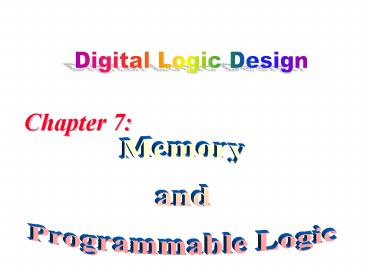Memory and Programmable Logic PowerPoint PPT Presentation
Title: Memory and Programmable Logic
1
Chapter 7
Digital Logic Design
Memory and Programmable Logic
2
Random-Access Memory (RAM)
- Data Storage (Volatile)
- Locations (Address)
- Byte or Word
Data input
Memory unit 16 x 8
Address
Read
Write
Data output
3
Random-Access Memory (RAM)
- Data Storage (Volatile)
- Locations (Address)
- Byte or Word
m Data input
Memory unit 2k x m
k Address
Read
10 Address lines? 1024 locations 1 K
Write
m Data output
4
Memory Decoding
- Memory Cell
Select
Output
Input
Read/Write
5
Memory Decoding
- Memory Array
6
Read-Only Memory (ROM)
ROM 2k x m
k Address
Memory Enable
m Data output
7
Read-Only Memory (ROM)
Conventional Symbol
Array Logic Symbol
8
Read-Only Memory (ROM)
- 8 x 4 ROM
3 x 8Decoder
0
1
2
I2
3
AddressLines
I1
4
I0
5
6
MemoryEnable
E
7
Output Data
9
Read-Only Memory (ROM)
3 x 8Decoder
- 8 x 4 ROM
0
Address Data
0 0 0
0 0 1
0 1 0
0 1 1
1 0 0
1 0 1
1 1 0
1 1 1
1
0 0 0 0
2
1 1 0 1
A2
I2
3
0 0 1 1
A1
I1
4
1 0 0 0
A0
I0
5
1 1 1 1
6
1 0 0 1
E
1
7
0 1 1 1
0 0 0 0
D2
D0
D1
D3
10
Types of ROMs
- Mask Programmed ROM
- Programmed during manufacturing
- Programmable Read-Only Memory (PROM)
- Blow out fuses to produce 0
- Erasable Programmable ROM (EPROM)
- Erase all data by Ultra Violet exposure
- Electrically Erasable PROM (EEPROM)
- Erase the required data using an electrical signal
11
Programmable Logic Device (PLD)
- Boolean Functions
- Sums-of-Products
- AND-plane followed by OR-plane
12
Programmable Logic Device (PLD)
- PROM
- PAL
- PLA
13
Programmable Array Logic (PAL)
- Example
- w(A,B,C,D) ?(2,12,13)
- x(A,B,C,D) ?(7,8,9,10,11,12,13,14,15)
- y(A,B,C,D) ?(0,2,3,4,5,6,7,8,10,11,15)
- z(A,B,C,D) ?(1,2,8,12,13)
- Simplify
- w ABC ABCD
- x A BCD
- y AB CD BD
- z ABC ABCD ACD ABCD
- w ACD ABCD
w
A
x
B
y
C
z
D
14
Programmable Logic Array (PLA)
A
B
C
Example F1 AB AC ABC F2 (AC BC)
15
Sequential Programmable Logic Device
- Basic Macrocell Logic
16
Homework
- Mano
- Chapter 7
- 7-1
- 7-2
- 7-3
- 7-18
- 7-19
17
Homework
7-1 The following memory units are specified by the number of words times the number of bits per word. How many address lines and input-output lines are needed in each case? (a) 4K ? 16, (b) 2G ? 8, (c) 16M ? 32, (d) 256K ? 64.
7-2 Give the number of bytes stored in the memories listed in Problem 7-1.
7-3 Word number 723 in a memory of 1024 ? 16 contains the binary equivalent of 3,451. List the 10-bit address and the 16-bit memory content of the word.
18
Homework
7-18 Specify the size of a ROM (number of words and number of bits per word) that will accommodate the truth table for the following combinational circuit components (a) a binary multiplier that multiplies two 4-bit, (b) a 4-bit adder-subtractor, (c) a quadruple 2-to-1-line multiplexers with common select and enable inputs, and (d) a BCD-to-seven-segment decoder with an enable input.
19
Homework
7-19 Tabulate the truth table for an 8 ? 4 ROM that implements the Boolean functions A(x,y,z) ?(1,2,4,6) B(x,y,z) ?(0,1,6,7) C(x,y,z) ?(2,6) D(x,y,z) ?(1,2,3,5,7)

